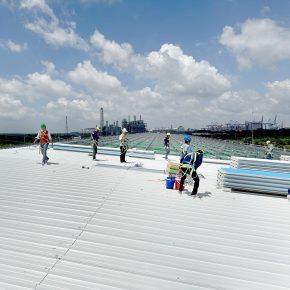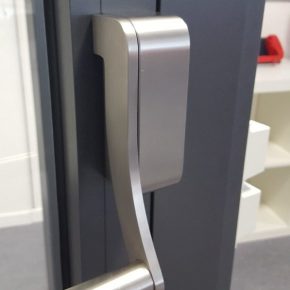
Key considerations for a garage conversion – Lidget Compton
The base is one of the most important elements of a concrete garage and, if built incorrectly, an unstable build, instead of a desired strong platform, could be the outcome. There are several factors to consider prior to converting a garage, which Lidget Compton discuss in this piece…
Dimensions
Firstly, look at the dimensions of the concrete and surroundings of the garage. Concrete garages from Lidget compton always ensure the surface of the base layer is at least four inches of compacted hardcore material and allow for an extra three inches around the perimeter for extra support.
Furthermore, many people often forget about the underground water level, which may affect the structure from beneath.
Lining the concrete base with a damp-proof sheet creates a waterproof seal stopping your structure succumbing to damages.
Cement
The second key factor to consider is the consistency of the cement used. In order to reach the perfect cement strength (also known as the Standard Consistency) the exact amount of required water must be added to form a paste.
This paste will be used on the base of the garage, so it is vital to ensure the exact amount of water is added, in accordance with the manufacturer’s instructions.

Weather
The next thing to consider is the weather conditions during the build, which could impact the cement consistency.
If it is raining, it is important to halt mixing or do so under cover to avoid any addition of rainwater which may change the cements consistency.
The cement base needs to be at least four inches thick on top of the compacted material and eight inches around the edges for extra support.
The following essential six step process can ensure you build a sound structure
1) Check the ground level, material substance and space
2) Accurately measure the consistency and depth of your cement
3) Start working on a dry day or at least make sure you are undercover out of the rain
4) Ensure the base layer is flat, consistent and level
5) Design the base layer to deflect water and add a waterproof sealant for additional protection
6) Allow 7 days for the concrete to set before building on top

Living Space
Garage conversions can be easy and often affordable, making them a very popular way of creating more space in a house, without any major building work. However, if a garage is being converted into a liveable space that requires warmth, it must have insulation.
One of the most crucial factors when beginning to insulate a garage is making sure it is completely airtight. Garages are not built to contain heat and, more than likely, lots of airgaps leading to the outside will be found.
The walls, ceiling, and doors of a garage can be insulated, but if the gaps are not filled, it will be an immense battle to keep the area heated.
When the place is completely sealed, all the windows and door frames need to be double checked, to make sure they are up to the task of preventing any drafts coming through.
The rate of how fast heat can be lost through an object is measured in U-Values. England, Scotland and Wales have different thermal standards, so it is important to meet the requirements that abide by the building regulations and standards.
The three main forms of insulation for a garage are as follows:
– Fiberglass Insulation
– Cellulose Insulation
– Foam Insulation
Ultimately, the decision is up to the person carrying out the project, when it comes to deciding which insulation material to use.
There are many different types of insulation to which satisfy different objectives.
Typically, a material which creates an air barrier is best to keep the cold air out. Insulations like fiberglass and cellulose do not do that, making foam insulation a popular choice.
Final Checklist
Perfecting the base and insulation are two of the most important considerations when constructing a secure and long-standing conversion.
Once they are in place, everything else will follow. Making a list of all key considerations to follow when converting a garage is a great way to achieve a successful build.
Lidget Compton has provided our very own checklist of key aspects to consider when looking to start a conversion.
– Always make sure the building is suitable to convert
– Check specific building regulations apply to the conversion
– Perfecting the base and the insulation is crucial for the durability of the conversion
– Ventilation will be required by building control
– Consider how electricity will be inputted
Once all of the above has been considered, the space will be ready to convert, in line with regulations, in order to ensure it is a comfortable and secure build for many years to come.
Latest news

15th April 2024
EJOT Colorfast chosen for Kingspan’s highly sustainable new Asian factory
More than 120,000 EJOT Colorfast self-drilling fasteners have helped Kingspan to create a thermally superior, visually-appealing building envelope for its first purpose-built manufacturing plant in South East Asia.
Posted in Articles, Building Industry News, Building Products & Structures, Building Systems, Case Studies, Posts, Restoration & Refurbishment, Retrofit & Renovation, Roofs, Sustainability & Energy Efficiency
15th April 2024
ASSA ABLOY helps new manufacturing plant achieve LEED Gold certification
Improving sustainability performance is becoming a higher priority for building developers, owners and users. One consequence is fast-growing demand for green building certifications — and therefore specification. Specialist input can make the difference between hitting and missing a project target, as ASSA ABLOY explains here…
Posted in Access Control & Door Entry Systems, Architectural Ironmongery, Articles, BIM, Infrastructure & CAD Software, Building Industry News, Building Products & Structures, Building Regulations & Accreditations, Building Services, Case Studies, Doors, Facility Management & Building Services, Information Technology, Retrofit & Renovation, Security and Fire Protection, Sustainability & Energy Efficiency
12th April 2024
Strand Hardware: D-Fine Makes a Splash for Seaside Safety
Strand Hardware’s D-Fine range is designed to withstand the harsh conditions prevalent in coastal environments. It is made from 316 stainless steel.
Posted in Access Control & Door Entry Systems, Architectural Ironmongery, Articles, Building Industry News, Building Products & Structures, Building Services, Doors, Facility Management & Building Services, Health & Safety, Innovations & New Products, Restoration & Refurbishment, Retrofit & Renovation, Security and Fire Protection
12th April 2024
GEZE UK – accredited as a Living Wage company
GEZE UK is delighted to announce that the company has been accredited as a Living Wage Employer. The real Living Wage is the only UK wage rate based on the cost of living.
Posted in Access Control & Door Entry Systems, Architectural Ironmongery, Articles, Building Industry News, Building Products & Structures, Building Services, Doors, Facility Management & Building Services, news, Security and Fire Protection
 Sign up:
Sign up: